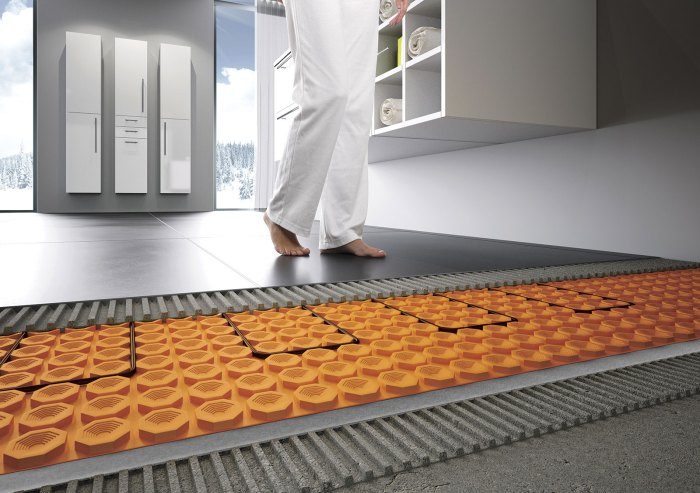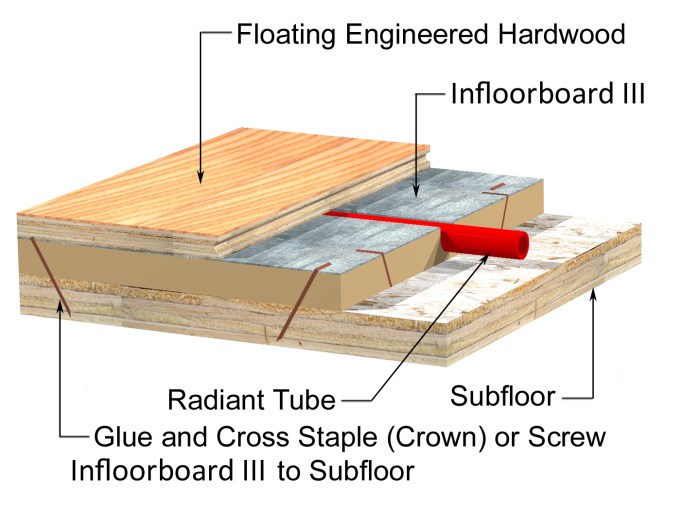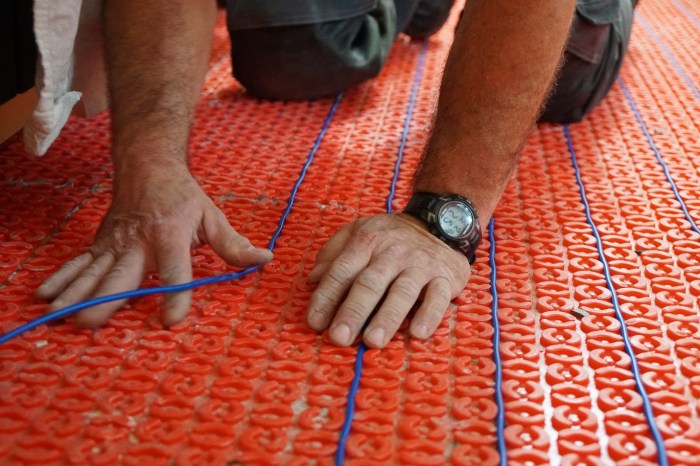Step into the realm of comfort and warmth with heated bathroom floors! These innovative systems transform your bathroom into a cozy sanctuary, but choosing the right thermal conductivity rating is paramount. Let’s delve into this essential aspect, exploring its significance and how it affects the efficiency, comfort, and longevity of your heated bathroom floors.
Thermal conductivity measures a material’s ability to transfer heat. In heated bathroom floors, materials with high thermal conductivity ratings efficiently distribute heat throughout the floor, ensuring an even and comfortable temperature. This not only enhances your bathing experience but also contributes to energy savings.
Thermal Conductivity Rating for Heated Bathroom Floors
The thermal conductivity rating of a material measures its ability to transfer heat. In the context of heated bathroom floors, this rating is crucial for ensuring efficient and comfortable heating.
Materials with high thermal conductivity ratings, such as ceramic tiles and natural stone, allow heat to flow through them easily, resulting in a more evenly heated floor surface. Conversely, materials with low thermal conductivity ratings, such as wood and carpet, impede heat flow, leading to less efficient heating and potential cold spots.
Factors Affecting Thermal Conductivity
Several factors influence the thermal conductivity rating of a material, including:
- Material composition: Different materials have inherent thermal conductivity properties based on their molecular structure and atomic bonds.
- Density: Denser materials tend to have higher thermal conductivity as they contain more molecules per unit volume to transfer heat.
- Temperature: Thermal conductivity can vary with temperature, with some materials exhibiting increased conductivity at higher temperatures.
- Moisture content: Moisture can act as a thermal insulator, reducing the thermal conductivity of a material.
Benefits of High Thermal Conductivity Ratings
Choosing materials with high thermal conductivity ratings for heated bathroom floors offers several advantages:
Energy Efficiency
Materials with high thermal conductivity transfer heat more efficiently, enabling the floor to warm up faster and maintain a comfortable temperature with less energy consumption. This reduces energy bills and promotes sustainability.
Comfort and Warmth
High thermal conductivity ensures that the floor surface feels warmer to the touch, providing greater comfort and coziness underfoot. This is particularly beneficial in cold climates or during winter months.
Considerations for Choosing a Thermal Conductivity Rating
Selecting an appropriate thermal conductivity rating for heated bathroom floors is crucial to ensure optimal performance and energy efficiency. Here are some key factors to consider:
1. Desired Heat Transfer Rate: Higher thermal conductivity ratings indicate faster heat transfer, resulting in quicker floor warming. Consider the desired level of warmth and the time frame within which you want the floor to reach the desired temperature.
2. Floor Construction: The type of flooring material and the presence of underlayment or insulation can influence the thermal conductivity rating required. Thicker or more insulating materials require higher ratings to achieve the same heat transfer rate.
3. Energy Efficiency: Higher thermal conductivity ratings generally lead to more efficient heat transfer, reducing energy consumption. However, it’s important to balance energy efficiency with other factors such as cost and durability.
Comparison of Thermal Conductivity Ratings
| Thermal Conductivity Rating (W/mK) | Suitability |
|---|---|
| <0.2 | Suitable for well-insulated floors or areas with mild climates |
| 0.2-0.5 | Ideal for most heated bathroom floors |
| 0.5-1.0 | Recommended for larger or poorly insulated bathrooms |
| >1.0 | Not typically recommended for residential applications due to high cost and potential for overheating |
Trade-offs: Choosing a higher thermal conductivity rating generally means increased cost, but it also leads to faster heat transfer and potential energy savings. It’s essential to weigh these factors carefully to determine the optimal rating for your specific needs.
Installation Methods for Heated Bathroom Floors
Installing heated bathroom floors requires careful consideration of the installation method to ensure optimal performance and longevity. The two primary installation methods are:
- Over-the-floor installation: This method involves placing the heating system over the existing subfloor and covering it with a new floor covering, such as tile or laminate.
- Under-the-floor installation: This method involves installing the heating system beneath the subfloor, providing a more discreet and evenly distributed heat.
Over-the-Floor Installation
Advantages:
- Easier to install, requiring less preparation.
- Suitable for renovations or existing bathrooms.
Disadvantages:
- May raise the floor level slightly.
- Less efficient heat transfer than under-the-floor installation.
Under-the-Floor Installation
Advantages:
- More efficient heat transfer, resulting in lower energy consumption.
- Discreet installation, with no visible heating elements.
Disadvantages:
- More complex and time-consuming installation.
- May require removing the existing floor covering and subfloor.
The choice of installation method should be based on the specific bathroom layout, existing flooring, and desired level of efficiency. For bathrooms with low thermal conductivity floors, over-the-floor installation may be sufficient. For bathrooms with higher thermal conductivity floors, under-the-floor installation is recommended to maximize heat transfer.
Maintenance and Troubleshooting for Heated Bathroom Floors
Maintaining heated bathroom floors is crucial for ensuring optimal performance and longevity. Regular cleaning and periodic inspections are essential to keep them functioning effectively. Common troubleshooting issues can arise due to various factors, but understanding the causes and solutions can help resolve them promptly.
Maintenance
Regular maintenance of heated bathroom floors involves cleaning the surface with a damp mop or vacuuming to remove dust and debris. Avoid using harsh chemicals or abrasive cleaners, as they can damage the surface. It is also important to check the electrical connections periodically to ensure they are secure and not loose.
Troubleshooting
- Uneven heating: This can be caused by faulty heating elements or improper installation. Check the connections and replace any damaged elements.
- Cold spots: Identify the cold spots and check for loose wires or damaged heating elements. Repair or replace the affected areas.
- Overheating: If the floor becomes too hot, it could indicate a malfunctioning thermostat or overheating elements. Adjust the thermostat or replace the heating elements.
- Electrical faults: If the floor does not turn on or experiences electrical issues, check the power supply and connections. If the problem persists, contact a qualified electrician.
Extending Lifespan
To extend the lifespan of heated bathroom floors, consider the following tips:
- Avoid placing heavy furniture or objects on the floor, as it can damage the heating elements.
- Use a floor mat to protect the surface from scratches and wear.
- Set the thermostat to a comfortable temperature to prevent overheating.
- Regularly inspect the floor for any signs of damage or malfunction.
Closure
Selecting the optimal thermal conductivity rating for your heated bathroom floors is a crucial decision. Consider your desired comfort level, energy efficiency goals, and budget. By understanding the factors that influence thermal conductivity, you can make an informed choice that will provide years of warmth and comfort in your bathroom.



